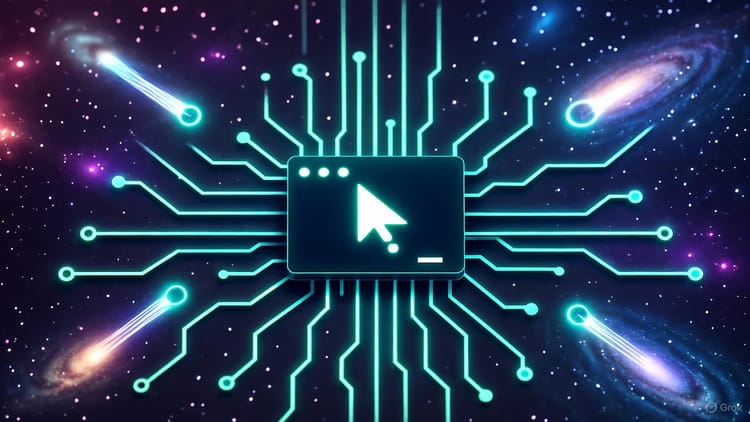The Rise of AI Agents: Building the Future with Stateful, Interoperable Intelligence

AI agents are revolutionizing how we interact with technology, moving beyond simple chatbots to autonomous, intelligent systems capable of reasoning, memory retention, and complex task execution. These agents are becoming the backbone of next-generation applications, from personal assistants to enterprise-grade automation. In this blog post, we’ll explore the evolving landscape of AI agents, focusing on key standards and frameworks like the Agent File (.af) standard, stateful agents from Letta, Lindy’s practical AI assistants, and Google’s Agent Development Kit (ADK) and Agent2Agent (A2A) protocol. Let’s dive into how these innovations are shaping the future of AI.
What Are AI Agents?
AI agents are autonomous software entities that leverage large language models (LLMs), memory management, and tool integration to perform tasks, make decisions, and interact with users or other systems. Unlike traditional AI models that respond to single prompts, agents maintain context, learn from interactions, and execute multi-step workflows. They can range from simple task automators to sophisticated multi-agent systems orchestrating complex operations.
The power of AI agents lies in their ability to:
- Reason: Analyze data and make informed decisions.
- Retain Memory: Maintain context across sessions for personalized, coherent interactions.
- Use Tools: Integrate with APIs, databases, or other agents to extend capabilities.
- Collaborate: Work with other agents to tackle large-scale problems.
Let’s explore the key standards and platforms driving this transformation.
The Agent File (.af) Standard: A Universal Format for Stateful Agents
One of the biggest challenges in AI agent development is portability—how do you share or transfer an agent’s state, memory, and behavior across platforms? The Agent File (.af) standard, developed by Letta and hosted on GitHub, addresses this by providing an open file format for serializing stateful AI agents.
Key Features of .af
- Comprehensive Serialization: An .af file packages an agent’s system prompts, editable memory (e.g., personality and user data), tool configurations, and LLM settings into a single, portable file.
- Interoperability: Designed for compatibility across frameworks, .af files allow agents to be shared, checkpointed, or version-controlled, much like a Git repository for code.
- Ease of Use: Developers can import/export .af files using Letta’s visual Agent Development Environment (ADE), REST APIs, or SDKs in Python and TypeScript. For example, importing an .af file to a Letta server is as simple as:
curl -X POST "http://localhost:8283/v1/agents/import" -F "file=/path/to/agent/file.af"
Why It Matters
The .af standard fosters an ecosystem where agents can be reused and shared across compatible platforms, reducing vendor lock-in and encouraging collaboration. Imagine downloading a pre-configured customer support agent and deploying it to your system with minimal setup. By standardizing agent serialization, .af paves the way for a marketplace of ready-to-use AI agents.
Letta: The Platform for Stateful, Long-Lived Agents
Letta is a pioneering platform for building stateful AI agents with advanced reasoning and persistent memory, born out of UC Berkeley’s Sky Computing Lab and the creators of MemGPT. Letta’s framework is designed to overcome the limitations of traditional LLMs, such as fixed context windows, by providing robust memory management and tool integration.
Letta’s Core Capabilities
- Long-Term Memory: Letta agents maintain conversational and contextual memory across sessions, enabling them to learn and improve over time. This is powered by MemGPT’s advanced memory management, which compiles relevant information to optimize LLM performance while keeping token usage low.
- Agent Development Environment (ADE): A visual interface for iterating on prompts, tools, and configurations, making it easy to debug and refine agent behavior.
- Tool Integration: Supports over 7,000 tools, executed in isolated sandboxes for security, allowing agents to interact with external APIs or databases.
- Sleep-Time Compute: A novel feature where agents use downtime to process data and refine their memory, enhancing performance without active user input.
Example Use Case
A Letta agent could power a personal finance assistant that remembers your spending habits, integrates with banking APIs, and proactively suggests budget adjustments. Its persistent memory ensures it recalls your preferences, while sleep-time compute refines its recommendations overnight.
Why Letta Stands Out
Letta’s open-source nature and model-agnostic design make it accessible to developers using various LLMs (e.g., OpenAI, Anthropic, or local models like Ollama). Its focus on stateful agents ensures long-running, context-aware interactions, ideal for applications requiring continuity, such as customer support or project management.
Lindy: Practical AI Agents for Everyday Workflows
Lindy takes a user-centric approach, offering AI agents designed to automate repetitive tasks and streamline workflows for businesses and individuals. Lindy’s agents are practical, no-code solutions that integrate seamlessly with existing tools like email, calendars, and CRMs.
Lindy’s Strengths
- Ease of Use: Lindy’s drag-and-drop interface allows non-technical users to create custom agents for tasks like scheduling meetings, responding to emails, or managing social media.
- Integration-Focused: Agents connect with popular platforms (e.g., Google Calendar, Slack, or Salesforce), making them immediately actionable in real-world workflows.
- Scalability: From single-task agents to multi-agent systems, Lindy supports a range of complexity levels, catering to both small businesses and enterprises.
Example Use Case
A marketing team could use Lindy to create an agent that monitors social media mentions, drafts responses, and schedules posts, all while syncing with their content calendar. The no-code setup ensures rapid deployment, even for teams without AI expertise.
Why Lindy Excels
Lindy’s focus on accessibility and integration makes it a go-to for businesses looking to adopt AI without overhauling their tech stack. Its agents are practical tools for boosting productivity, bridging the gap between advanced AI and everyday needs.
Google’s Agent Development Kit (ADK): A Developer-First Framework
Google’s Agent Development Kit (ADK) is an open-source, Python-based framework designed to simplify the development of sophisticated, multi-agent systems. Optimized for Google’s Gemini models but model-agnostic, ADK empowers developers to build production-ready agents with precise control.
ADK’s Key Features
- Multi-Agent Systems: ADK supports hierarchical agent architectures, where a coordinator agent delegates tasks to specialized sub-agents. For example, a weather bot might delegate greeting tasks to a separate agent.
- Rich Tool Ecosystem: Includes pre-built tools (e.g., search, code execution), third-party integrations (LangChain, CrewAI), and the ability to use other agents as tools.
- Native Streaming: Supports bidirectional audio and video streaming for human-like interactions, leveraging Gemini’s Live API.
- Developer Tooling: Offers a CLI (e.g.,
adk web,adk run) and a browser-based dev UI for debugging and visualizing agent behavior.
Example Code
Here’s a simple ADK agent that retrieves weather data:
from google.adk.agents import Agent
def get_weather(city: str) -> dict:
if city.lower() == "new york":
return {"status": "success", "report": "The weather in New York is sunny with a temperature of 25 degrees Celsius."}
return {"status": "error", "error_message": f"Weather information for '{city}' is not available."}
root_agent = Agent(
name="weather_assistant",
model="gemini-2.0-flash",
instruction="Answer weather queries using the provided tool.",
tools=[get_weather]
)
This agent can be extended to delegate tasks or integrate with external APIs, showcasing ADK’s flexibility.
Why ADK Shines
ADK’s code-first approach and seamless integration with Google Cloud (e.g., Vertex AI) make it ideal for developers building scalable, enterprise-grade applications. Its support for multiple LLMs via LiteLLM (e.g., Gemini, GPT-4o, Claude) ensures flexibility, while its CLI and dev UI streamline the development process.
Google’s Agent2Agent (A2A) Protocol: Enabling Agent Interoperability
To address the challenge of agents from different frameworks working together, Google introduced the Agent2Agent (A2A) protocol, an open standard for secure, interoperable agent communication. Backed by over 50 tech partners, including Salesforce and LangChain, A2A is poised to become the “HTTP for AI agents.”
How A2A Works
- Agent Card: A JSON metadata file (e.g.,
/.well-known/agent.json) that describes an agent’s capabilities, endpoint URL, and authentication requirements, enabling discovery. - Task Management: Agents communicate via tasks, which progress through states (e.g., submitted, working, completed) and support long-running operations.
- Modality Agnostic: Supports text, audio, and video streaming, ensuring flexibility across use cases.
- Secure by Default: Built on HTTP, SSE, and JSON-RPC, with enterprise-grade authentication aligned with OpenAPI standards.
Example Use Case
An expense reimbursement agent built with ADK and hosted as an A2A server can receive text requests, prompt for missing details via a web form, and complete the task once data is provided. The client agent discovers the reimbursement agent’s capabilities via its Agent Card and communicates securely over A2A.
Why A2A Is a Game-Changer
A2A complements frameworks like Anthropic’s Model Context Protocol (MCP) by focusing on agent-to-agent communication rather than tool integration. Its vendor-neutral design ensures agents from different ecosystems can collaborate, unlocking multi-agent workflows across platforms. For enterprises, this means seamless automation of complex processes, from customer service to supply chain management.
Comparing the Platforms
| Platform | Focus | Key Strength | Best For |
|---|---|---|---|
| Agent File (.af) | Agent serialization standard | Portability and interoperability | Sharing and version-controlling agents |
| Letta | Stateful, memory-driven agents | Long-term memory and reasoning | Complex, context-aware applications |
| Lindy | No-code, practical AI assistants | Ease of use and integration | Businesses automating workflows |
| Google ADK | Developer-first multi-agent systems | Flexibility and enterprise-grade tools | Scalable, production-ready applications |
| Google A2A | Agent interoperability protocol | Secure, cross-framework communication | Multi-agent ecosystems |
The Future of AI Agents
The convergence of standards like .af, platforms like Letta and Lindy, and Google’s ADK and A2A protocol signals a maturing AI agent ecosystem. Here’s what’s on the horizon:
- Standardization: Formats like .af and protocols like A2A will drive interoperability, creating a plug-and-play agent marketplace.
- Scalable Multi-Agent Systems: Hierarchical and collaborative agent architectures will tackle increasingly complex tasks, from autonomous research to enterprise automation.
- Accessibility: No-code platforms like Lindy will democratize AI agent adoption, while developer tools like ADK empower advanced customization.
- Sleep-Time Compute and Beyond: Innovations like Letta’s sleep-time compute will enable agents to “think” proactively, unlocking new levels of intelligence.
Getting Started
- Explore .af: Check out the Agent File repo and download sample .af files to experiment with portable agents.
- Try Letta: Deploy a Letta server via Docker and build a stateful agent using the ADE or Python SDK. Visit letta.com for tutorials.
- Build with Lindy: Sign up at lindy.ai to create no-code agents for your workflows.
- Dive into ADK: Install ADK via
pip install google-adkand follow the quickstart guide to build a multi-agent system. - Integrate A2A: Explore the A2A repo and test the protocol with ADK-based agents for interoperable communication.
Conclusion
AI agents are no longer a futuristic concept—they’re here, transforming how we work and interact with technology. The Agent File standard ensures agents are portable, Letta delivers stateful intelligence, Lindy makes AI accessible, and Google’s ADK and A2A provide the tools and protocols for scalable, interoperable systems. Whether you’re a developer, business owner, or AI enthusiast, now is the time to explore this dynamic ecosystem and build the agents of tomorrow.
What’s your next step? Will you serialize an agent with .af, automate a workflow with Lindy, or architect a multi-agent system with ADK and A2A? Share your thoughts in the comments, and let’s shape the future of AI together!


